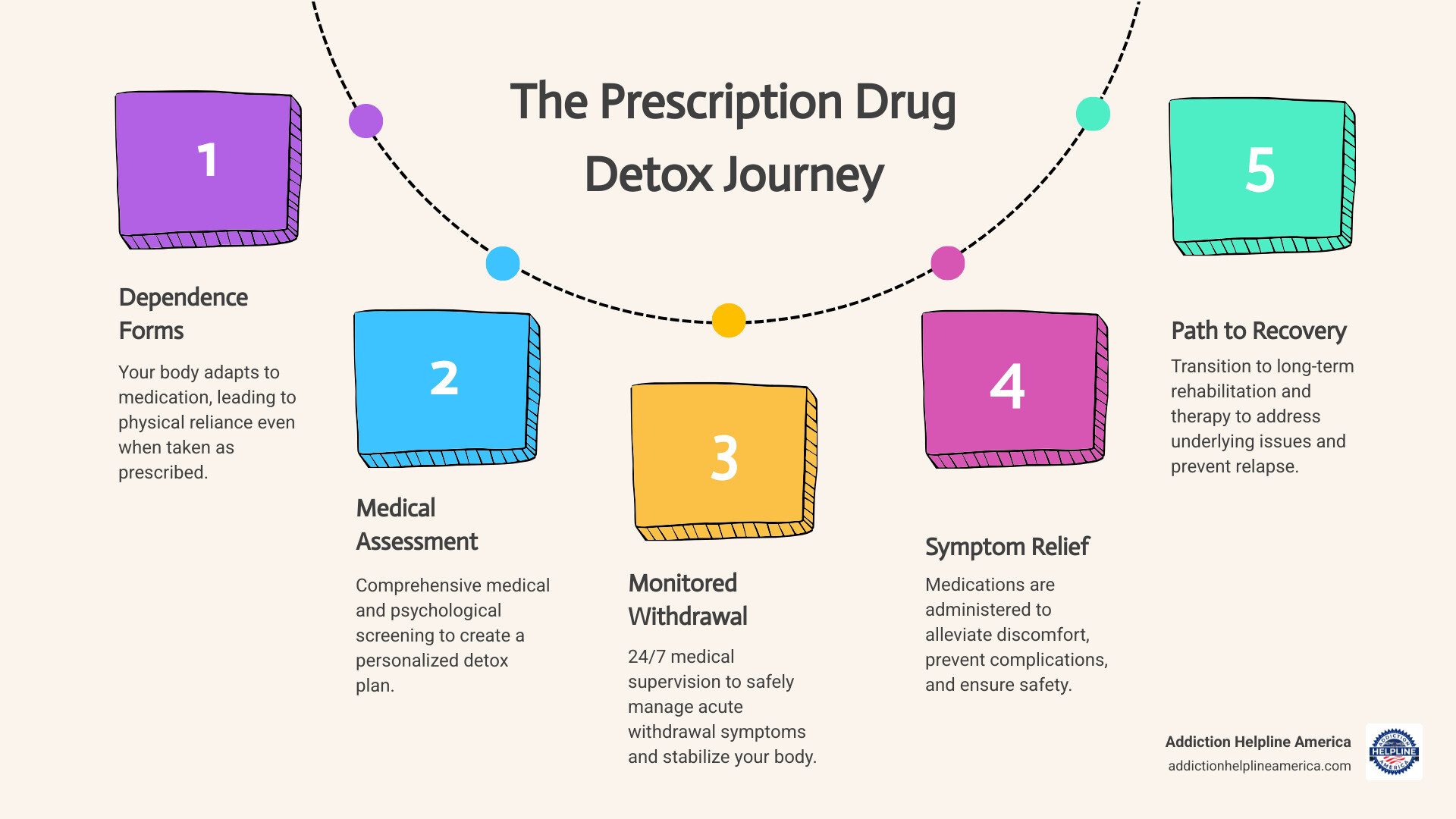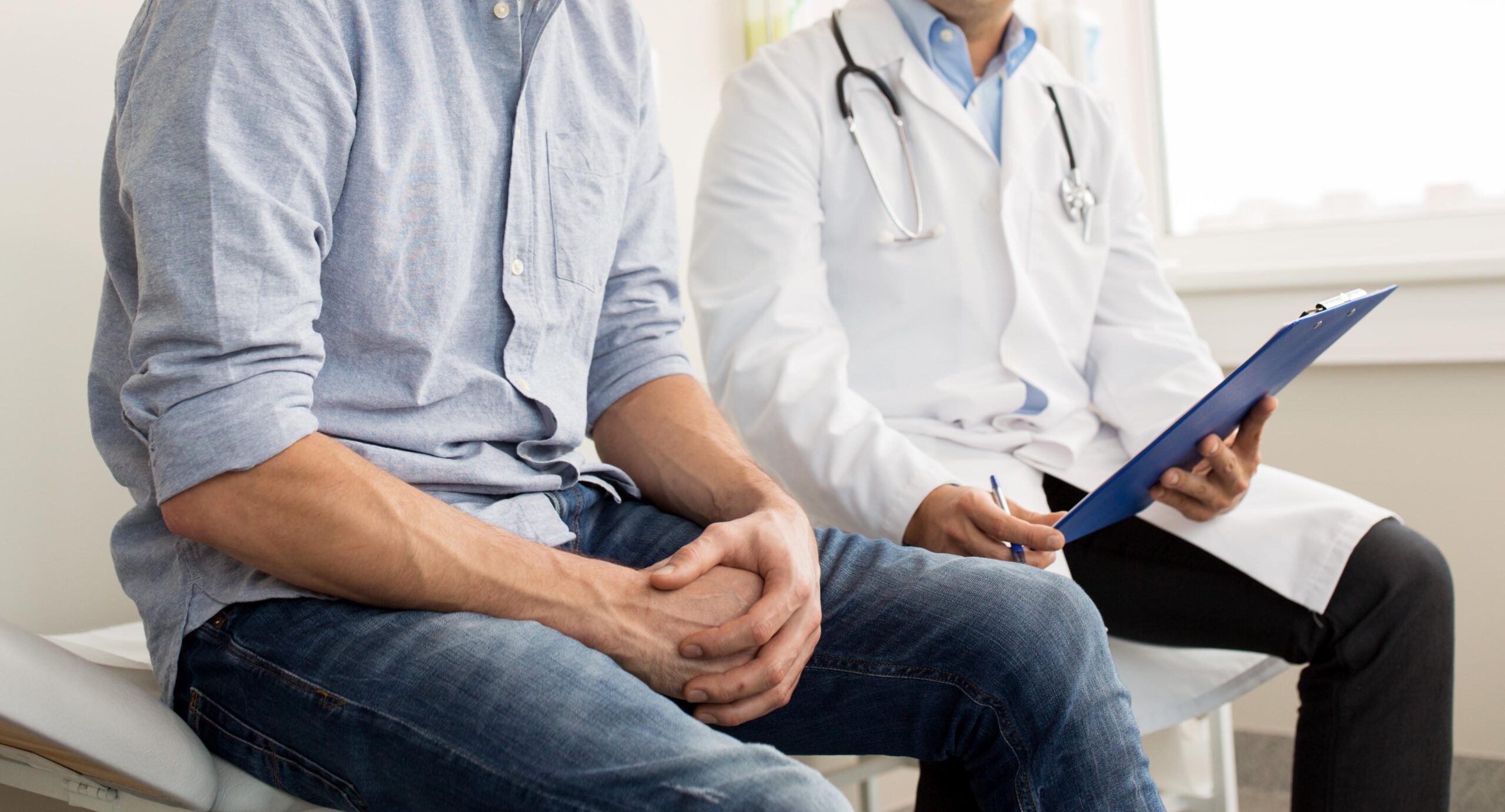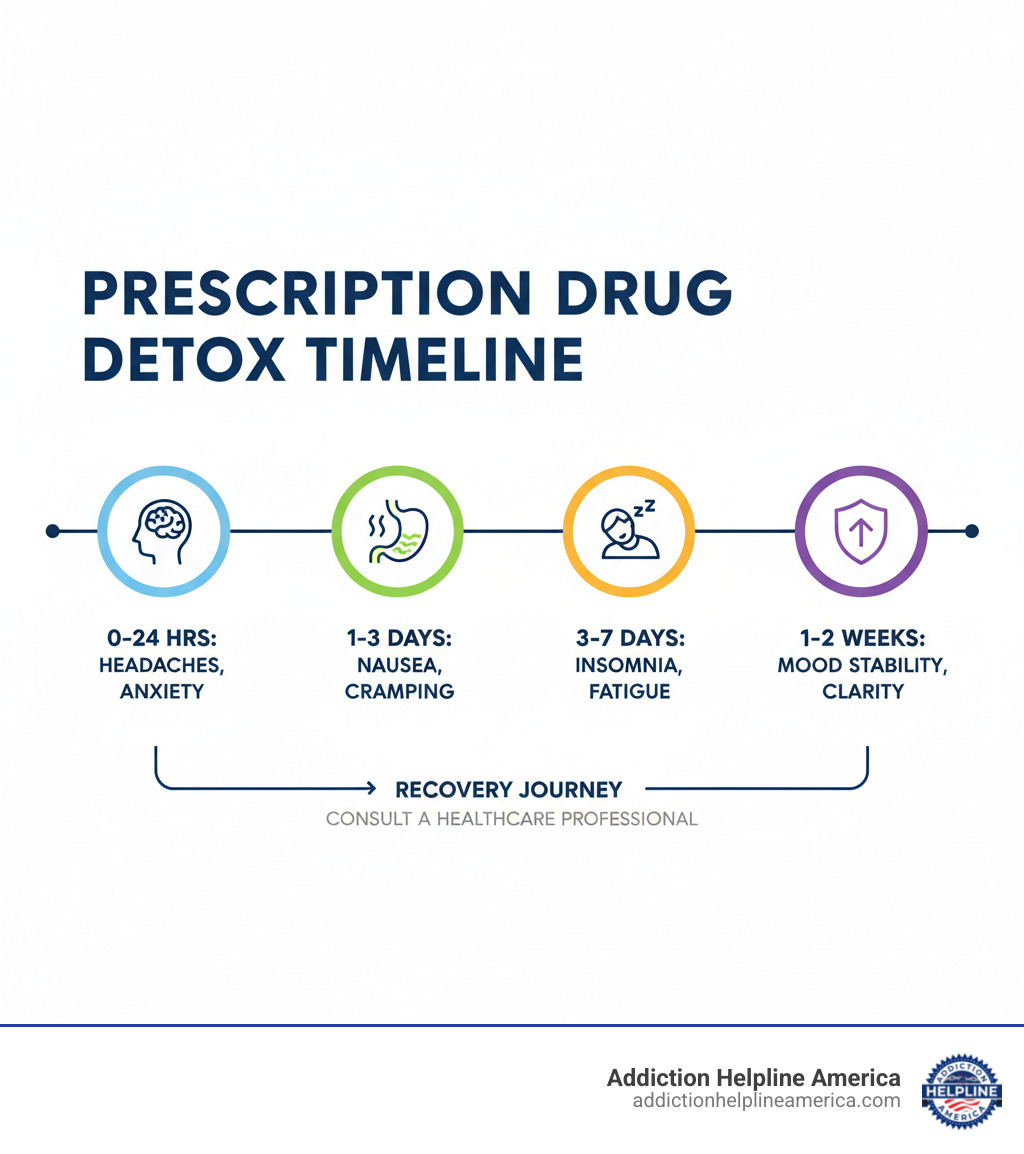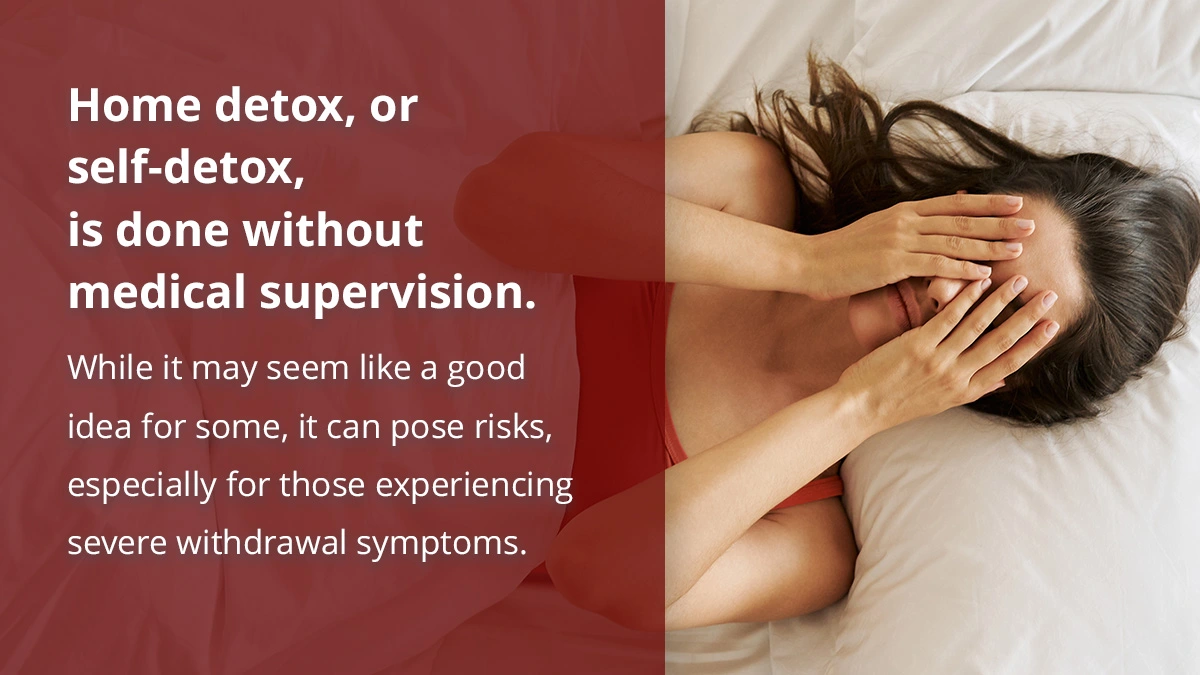Your Journey to a Healthier Life Starts Here
Free Insurance Verification
Verify Your Treatment Coverage
Verify Your Treatment Coverage
Detox from Prescription Drugs is the medical process of safely removing prescription medications from your body while managing withdrawal symptoms under professional supervision.
Key Facts About Prescription Drug Detox:
Dependence can develop even when you take medications exactly as prescribed. Your brain adapts to the substance, and stopping causes withdrawal. This is a medical condition, not a moral failing, and it requires professional treatment.
Withdrawal symptoms can be severe, ranging from muscle aches and nausea to seizures, hallucinations, and cardiac distress. Detox is the crucial first step in recovery, clearing the drugs from your system so you can begin addressing the psychological aspects of addiction. However, detox alone is not enough. It must be followed by comprehensive treatment to prevent relapse and build a foundation for long-term sobriety.
At Addiction Helpline America, our specialists have helped thousands connect with appropriate treatment. We understand that detox from prescription drugs requires personalized medical care and a clear path to lasting recovery.

Detox from prescription drugs is a medically supervised process that helps your body safely adjust as medications leave your system. When you take these drugs regularly, your body learns to function with them. Medical detox is the careful process of helping your body readjust to working without them in the safest, most comfortable way possible.

Take the first step towards a healthier life! Call now to connect with our compassionate team and start your recovery journey today. Your path to healing awaits!
Our recovery specialists are available 24/7 to provide support, and all calls are confidential and free. Reach out anytime – we’re here to help!

The core of detox is stabilizing your body and managing withdrawal symptoms, some of which can be dangerous. This step clears the physical hurdle so you can move into the deeper work of recovery. The Substance Abuse and Mental Health Services Administration (SAMHSA) emphasizes that medical detox provides the foundation for successful long-term treatment. During detox, medical professionals monitor you, minimize discomfort, and prepare you physically and mentally for the journey ahead.
Many prescription medications can lead to dependence, even when used as directed. Your body can become dependent over time, whether through misuse or prolonged use.
Addiction often develops as a way to cope with underlying issues like pain, anxiety, or trauma. Professional detox from prescription drugs connects you with the support needed to address these root causes.
Stopping prescription drugs on your own—”cold turkey”—can be dangerous and even life-threatening. This is a medical fact.
At Addiction Helpline America, we connect people with detox centers that provide this level of care because it saves lives and sets the stage for lasting recovery. Seeking professional help for detox from prescription drugs is the smartest, safest decision you can make.
When you stop taking a prescription drug your body has become used to, it enters withdrawal—a readjustment period as it tries to find its natural balance. The journey typically starts with an acute withdrawal phase, where symptoms are most intense. This can be followed by post-acute withdrawal syndrome (PAWS), where subtler symptoms like mood swings or trouble sleeping linger for weeks or months.

No two people experience withdrawal the same way. The type of drug, duration of use, and your overall health all shape your unique experience.
Symptoms during detox from prescription drugs can be both physical and psychological. Both are challenging and require compassionate medical attention.
Common Physical Symptoms:
Serious Physical Symptoms:
Common Psychological Symptoms:
Additionally, the original symptoms the medication was treating—such as pain or anxiety—often return temporarily, sometimes more intensely. This rebound effect is another reason professional support is crucial.
The timeline for withdrawal varies dramatically by drug. These are general patterns; your experience may differ.

Take the first step towards a healthier life! Call now to connect with our compassionate team and start your recovery journey today. Your path to healing awaits!
Our recovery specialists are available 24/7 to provide support, and all calls are confidential and free. Reach out anytime – we’re here to help!
| Drug Category | Onset of Symptoms | Peak Severity | Duration |
|---|---|---|---|
| Short-Acting Opioids (e.g., Oxycodone, Heroin) | 8–24 hours after last dose | 24–72 hours | 4–10 days |
| Long-Acting Opioids (e.g., Methadone) | 2–4 days after last dose | 3–8 days | 10–20 days (or 28+ days in some cases) |
| Benzodiazepines (e.g., Xanax, Valium) | 1–4 days after last dose | First 2 weeks | Weeks to months; protracted symptoms can last years (detox often 1+ week to 18 months) |
| Stimulants (e.g., Adderall, Ritalin) | Within hours to days | First few days | 3–5 days acute symptoms; psychological effects (depression, fatigue) can last weeks (often up to 2 weeks) |
These timelines underscore why professional medical support during detox from prescription drugs is essential. At Addiction Helpline America, we connect you with facilities that have the medical expertise to guide you safely through every stage of withdrawal.
It’s natural to consider detoxing at home, where you feel more comfortable and private. Concerns about cost or stigma are valid. However, when it comes to detox from prescription drugs, attempting to quit “cold turkey” at home is not just difficult—it can be deadly.

Statistics show that about 52% of people who attempt unsupervised detox experience severe, overwhelming withdrawal symptoms. The lack of medical support creates a perfect storm of physical danger and psychological distress that makes recovery incredibly unlikely.
Attempting detox at home is like navigating a storm without a crew or equipment. The risks are severe:
Fortunately, medical science offers tools to make detox from prescription drugs safer and more manageable. These interventions turn a dangerous ordeal into a structured medical process.
At Addiction Helpline America, we connect people with detox centers that provide this level of care. We are here to guide you toward a safe, supervised detox from prescription drugs that offers the best chance at lasting recovery.
Detox from prescription drugs is the starting gate, not the finish line. It clears the physical fog, allowing you to see the road to recovery. While detox addresses physical dependence, it doesn’t resolve the underlying reasons for addiction. True recovery involves learning new coping skills and building a life you don’t want to escape from. This is where comprehensive treatment begins.

A detox center is a structured, supportive environment. Your journey typically follows these steps:
If detox heals the body, rehab heals the mind and spirit. It helps you understand the root causes of your addiction and build a sober future.
Completing detox and following through with treatment opens the door to a new quality of life.
At Addiction Helpline America, we’ve seen thousands walk this path. Recovery is possible, and it’s worth every step.
Understanding the detox process can help ease anxiety and prepare you for what’s ahead. Here are answers to some common questions about detox from prescription drugs.
While the goal is always to safely clear substances from the body, detox from prescription drugs has unique aspects:
This is a difficult situation for many families. Generally, you cannot force an adult into treatment. Voluntary participation is a key predictor of long-term success. However, some states have involuntary commitment laws (like a Marchman Act) that can be used if a person is a danger to themselves or others. These are complex legal matters.
At Addiction Helpline America, we advocate for encouraging treatment through support and motivation. We can connect you with professional interventionists who guide families in compassionate conversations that often motivate a loved one to accept help willingly. A voluntary choice leads to the best outcomes.
No, they are two distinct and necessary phases of recovery.
In short, detox clears the path, but rehab teaches you how to walk it. Completing detox is a critical first step, but it is rarely enough for long-term sobriety without the comprehensive treatment that follows.
We’ve covered the essentials of detox from prescription drugs, from what it is to why it must be done under professional care. You now understand that detox is a medical process to manage withdrawal symptoms that can range from uncomfortable to life-threatening. The risks of at-home detox—from seizures to overdose—are too great to ignore.
Medical interventions like Medication-Assisted Treatment and 24/7 monitoring make detox a safe, manageable process. But remember, detox is just the beginning. Lasting recovery is built through the therapy, skill-building, and support that comes with comprehensive rehabilitation. Together, detox and rehab create a stable foundation for long-term sobriety.
Recovery is possible, and you don’t have to steer the path alone.
At Addiction Helpline America, our team of specialists provides free, confidential guidance to connect you with the right treatment program for your unique situation. We’ll help you find a personalized detox program that meets your needs and sets you on the path to a healthier future.
This moment is where change begins. Taking the first step is the most courageous thing you can do. Your healthier, happier future is waiting.
Ready to take the first step? Find a personalized detox program and connect with a specialist today.
Are you or a loved one struggling with addiction? Call today to speak to a treatment expert.
Calls to any general helpline will be answered or returned by one of the treatment providers listed, each of which is a paid advertiser:
Our helpline is available 24 hours a day, 7 days a week at no cost to you and with no obligation for you to enter into treatment. We are committed to providing support and guidance whenever you need it.
In some cases, Addiction Helpline America charges our verified partner a modest cost per call. This fee helps us cover the costs of building and maintaining our website, ensuring that we can continue to offer this valuable service to those in need.
Calls to the general helpline will be answered or returned by one of the listed treatment providers, all of whom are paid advertisers.
By using the helpline, you agree to the terms of use. We do not earn any commission or fee based on the treatment provider selected by the caller, and there is no obligation to pursue treatment.
This service is not affiliated with Alcoholics Anonymous World Services, Inc.